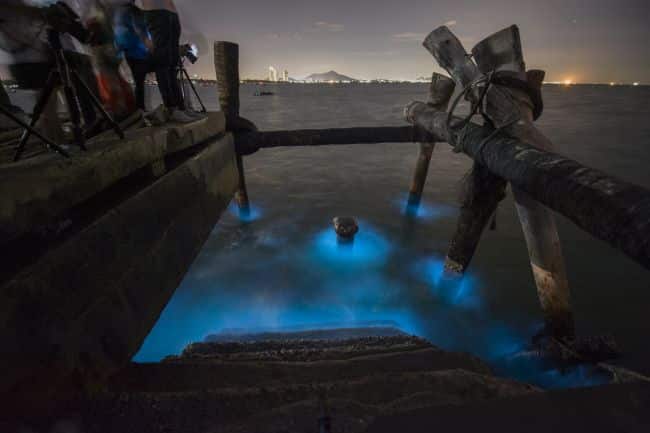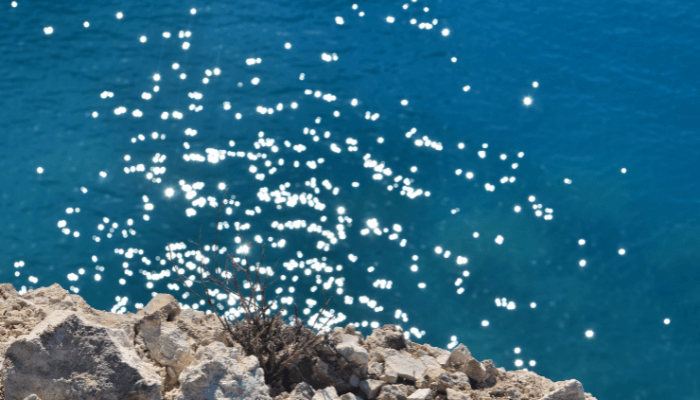Biobay: A Sea that Glows at Night
Ang Lee’s Oscar-winning movie, Life of Pi, thrilled spectators with the stunning beauty of the ocean at night, mainly when the bioluminescent fish create a cosmos underwater, illuminating the young Pi and his boat.
While the computer-generated visuals did the magic for the film, the natural phenomenon- bioluminescent bays-that light up the sea at night keeps offering the spectacle at different corners of the Earth.
The famous bioluminescent bays in the world include three bays in the waters near Puerto Rico, Jamaica’s Luminous Lagoon and Halong Bay in Vietnam.
Amongst the many wonders that form a part of the planet earth, there isn’t anything like Bio Bay, located in Puerto Rico. This bay is unique because it glows at night, turning into one of the most beautiful sights seen in the world.
With the rich presence of Pyrodinium bahamense, the single-celled organism behind the fantastic phenomenon, Bio Bay stands as the brightest bioluminescent bay in the world. At night, when stars start blinking in the sky, Bio Bay treats the spectators with the fantastic glow of blue-green light.
Location and Origin of Bio Bay
The Bioluminescent Bay, also known as Mosquito Bay, is located along the Caribbean coast on the southern shore of Vieques Island of Puerto Rico, a commonwealth of the United States. Puerto Rico also features two bio-luminescent bays: one located in the Laguna Grande in the town of Fajardo, while the other can be found in La Parguera near Lajas.
The Vieques Islands, however, were under Spanish colonization for nearly four centuries and are one of the constituents of the ‘Spanish Virgin Islands.’ Featuring several volcanic bedrock and sedimentary rocks in addition to several other geographic characteristics, Vieques Island remains one of the popular tourist destinations in the region. However, nothing but the Bioluminescent Bay makes the island most popular.

The bioluminescent bay was created quite inadvertently while the Spaniards controlled the islands. Unaware of the botanical rationale behind the light emission, the Spaniards were under misapprehension that the area was under a demonic influence. The Spanish believed that the phenomenon was the work of the devil and tried to bar the waters of the bay from entering the neighbouring sea waters with huge rocks and stones. However, these blockages resulted in the bay being created and the resultant secluded ambience allowing the dinoflagellates to breed much more effectively.
The segregation and alienation created the necessary conditions for Mosquito Bay, such as preventing modern development around the bay and helping the growth of red mangrove trees in the surrounding areas. The attempt to choke off the bioluminescent inlet from the ocean also resulted in creating a small channel, which now keeps the dinoflagellates in the bay.
Why does the Bio Bay glow?
Bioluminescence, which can also be referred to as luminescence in simple terms, is caused by a chemical reaction by microscopic organisms that dwell in the bay’s waters. The organism’s reaction acts as a defensive response – known as dinoflagellates – when they sense the water being disquieted by human contact or the fishes passing through. According to reports, up to 160,000 microscopic dinoflagellates per litre of the bay’s waters turn minor chemical reactions into magic.
The chemical that sets off this organism’s reaction is known as ‘luciferin.’ Hived away in the dinoflagellates cell, this chemical sheds an illuminating light when coalesced with oxygen. The chemical secretion is regulated automatically in the organism’s cell and is at its maximum at night, leading to a unique panorama.

This bioluminescence is further heightened by the fact that the bay’s depth is quite insufficient and also because of the dense foliage of mangroves. The leaves of the trees fall into the water and, in their decomposition, germinate vitamin B-rich bacteria. The dinoflagellates consume this bacterium which further accounts for their increment in the bio bay. Another important reason for the dinoflagellates in the basin is its restricted outlet to the sea. The limited space allows the organisms to proliferate and thrive in the bay.
Bio Bay-a tourist attraction
Most of the Island of Vieques was closed for quite long years by the US Navy, leaving the region undeveloped for decades. However, this very lack of developments now brought the island to the forefront of tourism as its unintentionally preserved natural beauties are attracting visitors from around the world. Being promoted as an unspoiled land with splendid geographical characteristics, Vieques is rapidly becoming a popular destination in the Americas.
Among the magnificent waters along the Caribbean coast, mosquito bay has been officially declared as the brightest by the Guinness Book of World Records 2008, making the bay a source of great tourist attraction from far and wide. While bioluminescence is seasonal in other parts of the world, the water off Vieques Island reportedly glows brightly year-round, strengthening its position as a major tourist destination.
In contemporary times, as a recreational and adventure activity, canoeing is permitted in the bay waters of the Vieques Islands. Even though tourists are restricted from swimming and using motorized boats in the seas, kayaks help them feel the blue water and its blue-green light under the new moon. The advertising promos also feature this part of the Vieques as being a major-scale tourist area, further augmenting the popularity of the island and the bio bay in duality.
Many tour operators offer guided tours, activities like paddling, kayak tours and much more. These are best enjoyed on a whole moon night. However, it is advised that people should avoid using hand creams, sunscreen, lotion or chemicals laden bug repellents that can potentially harm the organisms. Several efforts are being made to preserve the unique ecosystem sustained in the bay’s waters to ensure that this uniqueness does not dissipate due to unwanted activities.
It can be hoped that in light of several problems plaguing the many singular oceanic areas in the world, the beauty and wonder of the bioluminescent bay are retained substantially.
Frequently Asked Questions On Bioluminescent bays
1. How many bioluminescent bays are there in the world?
There are five bio bays in the world, and the three most famous ones are in Puerto Rico, Mosquito Bay, Laguna Grande and La Parguera. The other two lie in Luminous Lagoon, Jamaica and Halong Bay, Vietnam.
2. Can you swim in a Bioluminescent bay?
3. What is the world’s largest bioluminescent bay?
Mosquito Bay is the world’s brightest bio bay. It is located on the Puerto Rican island of Vieques, seven miles from the southeastern shores of Puerto Rico’s main island.
4. Why does the bay water glows?
Bioluminescence is caused by a chemical reaction by microscopic organisms that dwell in the bay’s waters. The organisms known as dinoflagellates react when they sense the water being disquieted by human contact or fish. The chemical that sets off this reaction is known as ‘luciferin.’ Hived away in the dinoflagellates cell, this chemical sheds an illuminating light when coalesced with oxygen.
5. What is the best time to visit the bio bays of Puerto Rico?
One can see bioluminescence in Puerto Rico all year round. However, many say that the best months to visit the bio bays are from December to May as the weather is pleasant and the waters are clear, making the experience even more serene.
You might also like to read-
- 11 Facts About The Bay Of Fundy
- 7 Major Ports on Hudson Bay
- Why is the Bay of Biscay Dangerous for Ships?
- 13 Important Bay Of Bengal Facts
Disclaimer: The authors’ views expressed in this article do not necessarily reflect the views of Marine Insight. Data and charts, if used, in the article have been sourced from available information and have not been authenticated by any statutory authority. The author and Marine Insight do not claim it to be accurate nor accept any responsibility for the same. The views constitute only the opinions and do not constitute any guidelines or recommendations on any course of action to be followed by the reader.
The article or images cannot be reproduced, copied, shared or used in any form without the permission of the author and Marine Insight.
Do you have info to share with us ? Suggest a correction
Subscribe To Our Newsletters
By subscribing, you agree to our Privacy Policy and may receive occasional deal communications; you can unsubscribe anytime.




I’ve always wanted to go to Bio Bay! When I found out swimming wasn’t usually allowed, I was a little disappointed, but kayaking sounds fun too. I don’t think I’ll be able to make a trip out there any time soon though. My boyfriend knew how much I wanted to go, and ended up getting me a really amazing gift. It’s a Dino Sphere, and it’s made by a company called Biopop. It’s a glass sculpture filled with dinofllagellates, so they use the chemical process described in the article to produce bioliminescence! I just wanted to share because I thought it was a neat way to experience bioluminescence at home if you can’t travel to Bio Bay or another spot where it occurs naturally.
Bio luminescence is best observed on a MOONLESS night. Tours do not even operate during the full moon.Vieques carefully regulates streetlights in the hills overlooking the bay as any ambient light interferes with being able to see the glow.